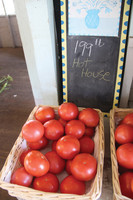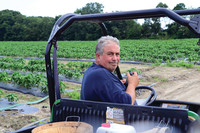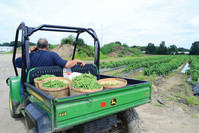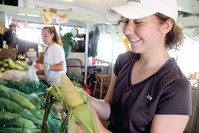In 45 years of farming, Vinny Confreda had never seen a spring like this.
“This year we’re hoping to even be able to break even and pay the bills,” said Confreda, owner of Confreda Farm off …
This item is available in full to subscribers.
We have recently launched a new and improved website. To continue reading, you will need to either log into your subscriber account, or purchase a new subscription.
If you are a current print subscriber, you can set up a free website account by clicking here.
Otherwise, click here to view your options for subscribing.
Please log in to continue |
|




In 45 years of farming, Vinny Confreda had never seen a spring like this.
“This year we’re hoping to even be able to break even and pay the bills,” said Confreda, owner of Confreda Farm off Airport Road in Warwick, which has been in his family since 1922.
While last year farmers had to deal with a significant drought, this year has posed the opposite, and worse problem - too much rain.
“It’s always a better problem if you don’t get enough rain because you can irrigate and make up for it,” Confreda said. “You can’t take water back out of the ground if there’s too much.”
Those heavy rains coupled with strong bouts of wind and unseasonable cold spells, followed abruptly by high summer heat waves, has wreaked havoc on “just about every product there is” at Confreda Farm.
Confreda said that, during a normal season, he harvests about 900 dozens of corn from an acre. So far this year, he said he is lucky to net 500 from those same acres. He outright couldn’t plant 25 acres because the fields were too flooded. The dip in production has caused corn prices to increase by as much as 80 cents per dozen, according to Confreda.
Eight acres of squash normally yields Confreda eight to 12 pallets of produce. This year? They’re averaging just a pallet and a half. Even more harshly affected has been his yield of peppers. In a normal year he would be picking about 400 bushels daily at this time. This year? Closer to 20 bushels.
John Morris, owner of Morris Farm on Warwick Avenue since 1978, agreed that he has never seen a spring quite like the one that just passed. By his measurement the farm got hit with between 15 and 17 inches of rain just in April and May.
Normally, Morris is finished making hay for his livestock and horses by the last week of June. “Tomorrow is the first day of August and I’m still cutting hay,” Morris said on Monday as his tractor idled in the background.
The historically bad spring has delayed crops by at least two weeks. Confreda said that they are off their normal production of crops for this time of the year by a shocking 80 percent. Morris reported his production was off schedule by at least three weeks.
As a result of the gap in production and the delay in harvesting, Confreda said the farm is currently not making payroll. He has had to dip into personal finances to pay his nearly 30 employees, who still have to tend and maintain the same large amount of farmland - including two main farms in Warwick and Cranston as well as about 15 planting locations throughout the state.
“In terms of a spring it was one of the worst I’ve ever seen,” said Ken Ayars, Chief of Agriculture for the Rhode Island Department of Environmental Management (DEM) for the last 20 years, and an employee of DEM for 30. “Absolutely no doubt about that.”
Here comes the sun
The spring was so bad, in fact, that Ayars said the entire Northeast was on a “tipping point,” verging on an agricultural disaster. Thankfully, recent weeks have brought a more consistent pattern of sun and light rain, with steady temperatures throughout. The sorely-needed regulation came just in time to hopefully salvage the final stretch of the harvest season in the upcoming fall.
“If it wasn’t for the weather getting significantly better, I think the season for many farmers would have been close to a disaster to be honest,” Ayars said. “The weather getting better has allowed some measure of crop production and a chance to catch up in a sense, but you can't catch up in all respects.”
Ayars said that large farms without the ability to climate-control their crops (in a greenhouse for example) are more at the whim of natural ebbs and flows of Mother Nature than the smaller farms that tend to participate in local agricultural events like farmers’ markets. Those small farms, he said, are doing historically well in the state.
“Overall trends are very good despite the challenges in farming,” he said. “There’s a lot of interest in agriculture...farms tend to be smaller than they were 10 to 15 years ago.”
Being at the mercy of nature lies at the heart of farming. All a good farmer can do is react to situations as quickly and as best they can. Confreda and Morris both raised their rows of crops to try to insulate them from standing water that collected due to the consistent rainstorms.
But no matter how savvy or smart, faith plays a big role for farmers as well.
“In this business you just have to try to keep smiling and stay optimistic,” said Confreda, who said he is hopeful that the crops will continue to emerge later into the season and he will be able to make up for the losses sustained during the early parts of the season.
Morris agreed almost verbatim.
“That’s farming,” he said. “You can’t control the weather. You just have to stay positive and hope for the best.”
It may not be a bad thing, after all, to wait a little longer for the best selections at your favorite local farm stand. As John Morris guaranteed with a smile, “The best sweet corn comes after Labor Day.”
Comments
No comments on this item Please log in to comment by clicking here